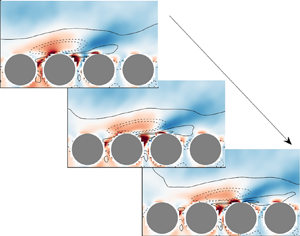Article contents
Spatial and spectral characteristics of information flux between turbulent boundary layers and porous media
Published online by Cambridge University Press: 23 September 2022
Abstract

The interaction between boundary layer turbulence and a porous layer is the cornerstone of interface engineering. In this study, the spatial and spectral-resolved transfer entropy is used to assess the asymmetry of the causal interaction next to the permeable wall. The analysis is based on pore-resolved direct numerical simulation of turbulent channel flow over cylinder arrays. The spatial map of transfer entropy reveals the information flux between the porous medium and arbitrary nearby positions, and paths connecting locations with maximum information transfer are identified. The paths in the ‘top-down’ and ‘bottom-up’ directions, respectively, lean upstream and downstream, demonstrating that the coupling process is directionally dependent. The scale dependence of transfer entropy is inspected with a surrogate data strategy. As wall permeability increases, the active scale range in causal interaction shifts from near-wall vortices to Kelvin–Helmholtz type eddies. In addition, linear stochastic estimation is used to determine the statistical velocity field for a local informative event. In an average sense, the interaction between a convecting sweep or ejection event and the up/down-welling motions at the pore unit is the core mechanism that contributes to the causal coupling. The statistical findings derived from the transfer entropy are then validated using a neural network-based remote sensing model.
- Type
- JFM Papers
- Information
- Copyright
- © The Author(s), 2022. Published by Cambridge University Press
References
- 12
- Cited by



